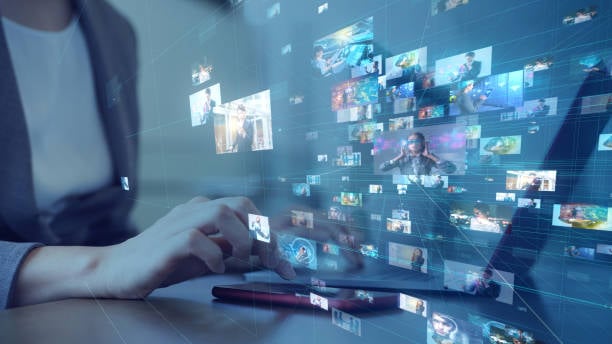July 12, 2023
 by Victor Riparbelli / July 12, 2023
by Victor Riparbelli / July 12, 2023

Think about your typical workday. How many hours do you spend creating content? Emails, presentations, reports, social media, and so on.
Let's guess.
A lot.
Each of these must be carefully written, visually appealing, and, if possible, interactive. There’s a good reason for that, of course.
As a society, we’re moving toward rich and digital-first modes of communication, and the demand for high-quality content has never been greater. This holds for both individuals and businesses who can benefit greatly from using artificial intelligence (AI) to scale their content production.
Synthetic media is an umbrella term for any media moderated or fully generated by AI. Text, voice, images, videos, music, and even code can now be generated by machines, making it easier than ever to create high-quality content.
As once-predominantly physical processes are shifting to the digital world, anyone can become a creator. What in the past required specific technical skills is now becoming accessible to everyone and, perhaps most importantly, truly scalable.
Does this mean people will lose their jobs to technology?
The short answer is no.
Many generative AI tools that offer various solutions to help you do your job faster are emerging daily. However, a human is still needed at the very beginning and end of the creative process; it’s a real person who needs to write the prompt, it’s a real person who decides on the intent, and it’s a real person who can further refine the content generated by AI.
AI isn't a replacement but an extension of our creative capabilities, enabling us to meet the demands of high-quality, tailored content for different audience touchpoints. The typical customer journey has never been more fragmented, and customer expectations for brand interactions have never been higher. This has led to the point where, in one way or another, most white-collar workers spend most of their time creating content.
AI can help us in these efforts.
If you want to learn more about concrete use cases of AI-generated content you can use to scale your business, read on.
One could almost say that everything starts with text. Language as a human-only technology determines how we see and think about the world and communicate with others. But let’s face it: even though we literally think in words, writing is not everyone’s cup of tea.
Thanks to large language models, many AI writing generators can now help us with it. And I'm not talking about AI for translation and spell-checking. I’m talking about tools that can generate entirely new and unique pieces of writing based on your prompts.
Various AI text generators have existed before, but ChatGPT has taken their adoption to a whole new level. I’m almost 100% sure you’ve already tried it out and got a glimpse into this new way of producing text.
Source: ChatGPT
Here are some concrete ideas on how to leverage AI when it comes to writing.
From ideation to keyword research to writing the actual copy, AI writing tool can speed up your blog post-writing process so that you focus more on your blog's creative and strategic aspects.
Almost every employee today spends at least some time writing emails, and you probably have some automated email sequences that go out to your customers. Why not let AI do the heavy lifting of generating text for your emails? You can ask it to write subject lines, body copy, calls to action, create A/B variants, and more.
Each social media platform has its specifics, and it’s not good enough to use the same copy for each. AI can help you write social media captions of different lengths and styles, descriptions for your multimedia, and less visible tasks such as post ideation, hashtag research, and alt texts.
If you’ve ever written a video script, you know it’s not the easiest job. Audiences simply want more dynamic and fast-paced content, and video should be an integral part of your strategy. Luckily, you can use many AI tools to write different parts of your video script, such as dialogs, narration, and scenes.
There’s a lot of written content besides the examples we just mentioned. Some reports need to be written precisely, presentations that require additional text, and job descriptions that could be even more compelling if using the right language. We’re just listing a few examples here because the possibilities for where and how to use AI in writing are pretty much endless.
Scaling your content is only half the story. Editors polish AI-generated text into publish-ready content. Explore how to launch your editing career.
AI can help you write copy for any kind of verbal communication, but here’s the thing – the visual aspect of a message is just s important. If you have a designer who’s always willing to help, then great. But if you're preparing various visual assets for your business, it's time to ask AI for help.
You can benefit from AI in two ways when it comes to images. First, you can edit existing images. What used to require specialized design skills can now be done with a single click.
We're talking about tasks like removing backgrounds, fixing pixelation, adding different image elements, and more. Second, you can ask it to generate entirely new images from scratch. Text-to-image models can generate anything you can think of in either an artistic or realistic style.
Source: Stable Diffusion
Here are some ideas on how AI can help you save time, money, and perhaps some nerves when creating images:
One from above. One in action. One from a distance. Anyone working in sales or marketing would agree: there are never enough product images. However, organizing photo shoots and hiring professional photographers can be a hassle. But worry not! You can now achieve the same results using AI image generators–without breaking the bank.
Once you have enough product images, it’s time to showcase them on your social media channels. But each channel requires different styles of visuals in different aspect ratios. Instead of spending hours on designs, take advantage of AI tools to generate and optimize your assets for multiple platforms.
Images are an essential part of any video. You can use them to further support the communicated idea, present details, visualize data, and more.
Creating presentations can be a lengthy process. It can take weeks, from ideation to defining content to the final design stage. While the ideation is still on you, AI can help you quickly create visually stunning slides that will wow your audience.
Whether you need a particular image for a printed ad or want to design a brochure, AI has you covered. Use it to speed up the process, stay on-brand, and generate unique images right in your browser.
Memes, logos, art pieces, or portraits of people – any type of image you can think of, AI can generate it in minutes.
Do you feel comfortable recording yourself speaking? Well, most people do not.
While hiring professional voice actors isn't always an option, various text-to-speech generators are becoming increasingly popular. Generating narration from text is a simple process that can be done in a browser. And if you think synthetic voices all sound robotic, you should try them.
Most text-to-voice generators offer numerous stock voices to generate narration in different languages, accents, and tones. You can also clone your own voice if the stock voices are insufficient. Another great feature of AI-generated speech is that it can be easily updated without repeating the entire process.
And the best part? Creating multiple language variants is only a matter of a few clicks!
Not surprisingly, many companies already use AI voices to personalize and localize their audio content. Here are some examples.
When you create a video, its visual aspect is the most obvious. But audio is just as important. Using text-to-speech tools, you can play around with different combinations of voices for dialogs between characters and select the narrator’s voice that best supports the overall mood of your video.
The same goes for your presentations. You’ve probably made them visually appealing, so why not provide extra information via audio? Select the voice that fits your presentation, type in the text, and simply add it to your slides.
Every company should become a media company today, but it’s easier said than done. However, the number of podcast listeners is increasing, and creating your own podcast seems like a great idea.
You have exciting insights, compelling stories to tell, and a pool of listeners who might be interested but no podcast host. Don’t worry – pick a synthetic voice, generate the audio file, and share it with the world!
Audio can also be an effective medium to communicate with your product or service users because it’s more engaging than text and speaks to people’s emotions. Incorporating voice assistants at various touchpoints can elevate the customer experience, and it’s never been easier to deploy one using a text-to-speech generator.
Make sure you select a brand-appropriate voice, translate and localize the content, and delight users with speech instead of boring text.
As society moves toward rich media and our attention spans shorten, the demand for video is growing. Consumers want to learn about products through video instead of pictures, students want to watch bite-sized videos instead of reading, and companies are trying to produce more video content faster.
On social media, videos are shared 1,200% more often than links and text combined, and it’s no surprise. Videos immediately grab attention and keep the viewers engaged. In fact, they retain 95% of a message when watching a video, compared to only 10% when reading text.
But traditional video production is, put nicely, not very accessible. Just think about all the equipment, hiring actors, and finding the right location – and it’s only the beginning. Once the video is done, it’s set in stone, and updating it seems almost impossible.
In contrast, synthetic video can be generated in a browser using only one tool, and the process couldn’t be more intuitive even for absolute beginners. Most AI video generators offer AI avatars to act as presenters, the ability to upload branded assets, and other video editing features.
Here’s how AI can help you bring your video content ideas to life.
Did you know that the ability to learn is one of the biggest motivators for employees to stay at a company? Quality training in the workplace is more important than ever, and bite-sized video is one of the most effective learning tools. Bonus points if you make it interactive and include a realistic talking head!
Your marketing department produces a lot of content, and AI-generated video is an excellent way to enhance those efforts. This research on AI video trends shows how users use AI video to repurpose different pieces of content they already have or to create new ones. Video testimonials, how-to videos, explainer videos, and social media videos can easily be generated with various AI video generators and their numerous templates.
Show, don’t tell. This perfectly explains why video is an excellent format for customer support. It provides answers quickly and allows for clear visualization of different processes. Including an AI avatar may also be a good idea, as it helps humanize your customer-facing interactions.
Video is an attractive medium to spice up meetings, share company updates, or deliver other important information. Many companies are converting static presentations into video format; some even use AI videos to replace real-time meetings.
Whether a casual email exchange or a well-thought-out marketing sequence, including a video in an email, makes it more engaging and memorable. Research shows that just mentioning the word "video" in the subject line increases open rates by 6%. With all the AI video generators on the market, now is an excellent time to start creating more videos for your email comms.
In this visual-first era, the sound aspect of branding is often overlooked – especially if your business doesn’t operate in a physical space. However, there are some cases where music still plays a significant role.
Thanks to AI music generators, you no longer have to hire musicians or worry about copyright issues. You can generate your music with different AI tools, where you specify the instruments, mood, style, and other audio parameters and get it in minutes.
Let’s take a look at some use cases.
Remember when we discussed podcasting earlier in this article? Well, voice narration is only one part of a podcast. Another, and a super important one, is music. And that’s where you can use AI music generators for intros and outros, background music, transitions between topics, and other musical inserts to signal specific sections of your podcast.
Background music in videos is essential as it can set the mood and tone of the content, helping engage and captivate viewers. It can also fill awkward silences or distractions, creating a more polished and professional final product.
Same as for videos, music can create an atmosphere in physical spaces. Therefore, it can be a powerful tool to create a memorable experience consistent with your brand.
As you can see, there are many ways generative AI can help you create more and better content. The best solution naturally depends on several factors, such as your content strategy, existing skills on the team, and available resources.
As technology evolves rapidly, new tools are being launched for almost every use case imaginable. Your team must identify the ones you need and develop new skills needed to put them to work. AI tools are not complex to use, but they require understanding the processes behind them to achieve optimal results.
Synthetic media will change not only the way we create content but also the way we consume it. It has important implications for society as such, bringing many benefits but also some risks, which is why AI content detectors are becoming essential for verifying authenticity and maintaining trust in an increasingly AI-driven world.
As with any other new technology, people will adapt and become more educated and critical of AI-generated content. There will also be bad actors using these powerful technologies, and it’s up to businesses, regulators, and individuals to do everything we can to prevent misuse.
Sufficiently advanced technology is indistinguishable from magic, said the late Arthur C. Clarke. The capabilities of AI already seem magical, but what we're currently seeing is just the tip of the iceberg. It’s impossible to say where future developments will take us, but they will open up many unforeseen ways for creative expression and provide significant value to businesses.
We believe that the future is synthetic, and are beyond excited about the possibilities all these AI tools are about to unlock.
AI is an ever-evolving landscape to keep up with. Check out these recent trends in AI and how cheaper and easy-to-use AI will make your life better.
Victor Riparbelli is CEO and Co-Founder of Synthesia, the world’s leading AI video generation platform. The company’s mission is to make video easy for anyone by moving video production from the physical to the digital world.
Web accessibility implies giving everybody access to the same information irrespective of the...
 by Ashwini Dave
by Ashwini Dave
Which would you understand more easily - a block of text explaining how to tie a Double...
 by Kelly Wade
by Kelly Wade
Digital engagement allows your business to connect with customers in many different ways.
 by Vanita Rana
by Vanita Rana
Web accessibility implies giving everybody access to the same information irrespective of the...
 by Ashwini Dave
by Ashwini Dave
Which would you understand more easily - a block of text explaining how to tie a Double...
 by Kelly Wade
by Kelly Wade


